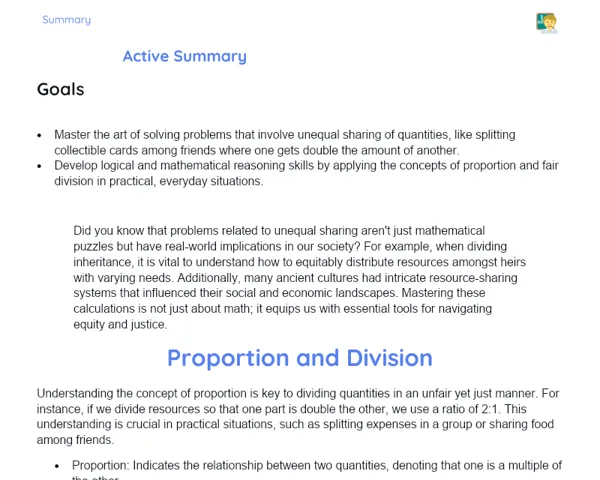Objectives
1. 🎯 Grasp the structure of a complex number by identifying its real and imaginary parts.
2. 🎯 Determine the type of a complex number — whether it is real, purely imaginary, or simply imaginary.
3. 🎯 Use the knowledge gained to tackle practical problems, thereby enhancing logical and critical thinking skills.
Contextualization
Did you know that complex numbers are not merely a mathematical theory but have amazing real-world applications? For example, they play a vital role in electrical circuit design and in simulating electromagnetic waves in engineering. This concept, which may seem abstract, is what helps your smartphone function, among other devices! Learning about complex numbers goes beyond mathematics; it's about discovering a unique language that describes the world around us!
Important Topics
Real Part
The real part of a complex number is the value that is independent of the imaginary unit 'i'. In a complex number expressed as z = a + bi, 'a' is the real part. This component is essential to relate complex numbers to conventional real numbers, acting as the base on which the imaginary part is built.
-
Represents the horizontal coordinate in a complex plane, helping us visualize the complex number as a point or vector.
-
In practical situations like electrical circuits, the real part may depict the size of a wave or signal.
-
Crucial for operations such as adding and subtracting complex numbers, where we combine the real parts separately from the imaginary parts.
Imaginary Part
The imaginary part of a complex number is the coefficient of the imaginary unit 'i'. For a complex number z = a + bi, 'b' denotes the imaginary part. This component allows us to extend the realm of real numbers to solve issues for which there isn’t a solution within real numbers, such as finding the square root of negative numbers.
-
Represents the vertical coordinate in a complex plane, aiding the geometric understanding of complex numbers.
-
Essential for physical phenomena involving phases, such as electromagnetic waves, where the imaginary part can signify the phase of the signal.
-
Important for multiplying and dividing complex numbers, where the properties of the imaginary unit 'i' (i.e., i² = -1) come into play.
Pure Imaginary Numbers
A pure imaginary number is a unique case of a complex number where the real part is zero, expressed simply as bi. These numbers are fundamental in understanding the imaginary unit's operation and its application in mathematical and physical scenarios where only the imaginary dimension is relevant.
-
Used to simplify the representation of phenomena that function perpendicular to the real axes, like certain properties of waves.
-
Helps in understanding and calculating operations involving square roots of negative numbers.
-
Vital for studying the nature and characteristics of the imaginary unit 'i', both in academic and practical settings.
Key Terms
-
Complex Number: An extension of real numbers that includes both a real and an imaginary part.
-
Real Part: The section of a complex number that does not include the imaginary unit 'i'.
-
Imaginary Part: The section of a complex number that is multiplied by the imaginary unit 'i'.
-
Imaginary Unit 'i': A key concept in mathematics defined by the property that i² = -1.
For Reflection
-
How does the concept of complex numbers enhance our understanding of basic mathematical ideas like square roots?
-
In what ways does the imaginary part of a complex number broaden our ability to solve challenges in physics and engineering?
-
What would the repercussions be for mathematics and science if the imaginary unit 'i' had never been introduced?
Important Conclusions
-
Today, we explored the intriguing realm of complex numbers, diving into their real and imaginary aspects, and grasping how they can be categorized as real, pure imaginary, or simply imaginary numbers.
-
Complex numbers transcend being just an advanced math tool; they are integral to many real-world applications, ranging from electrical engineering to quantum physics.
-
The capability to manipulate complex numbers paves the way for solutions to problems that would be impossible using only real numbers, illustrating how mathematics can push our limits of understanding and application.
To Exercise Knowledge
Start a math journal: For one week, jot down everyday instances where complex numbers could come into play. This could be anything from calculating areas of complex shapes to grasping electrical signals in household gadgets.
Challenge
Complex Poster Challenge: Create a vibrant and imaginative poster explaining what complex numbers are, including examples of their application in real-life contexts. Share your poster with the class or on your school's social media to inspire fellow students!
Study Tips
-
Utilize math apps or interactive websites that allow you to visualize graphs of complex numbers, aiding in comprehending their geometric nature.
-
Form a study group with friends to discuss and solve problems pertaining to complex numbers, which can provide you with varied perspectives on the content.
-
Try explaining the idea of complex numbers to someone unfamiliar with the topic. Teaching is one of the best ways to reinforce your understanding.



